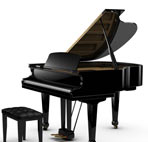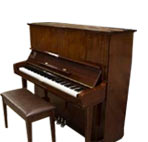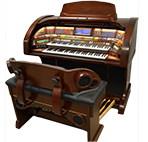Piano Maintenance and Piano Care Tips
How Often Should My Piano Be Tuned? | Humidity | Temperature | Who Should Work on My Piano?
Working with My Technician | Pitch Raising | Tuning | Cleaning Your Soundboard
The "Key" to Cleaning Your Piano Keys | Cleaning the Cabinet | Moving Your Piano
How Often Should My Piano Be Tuned?
There is no absolute rule as to how often your piano must be tuned; however, it is recommended to tune your piano once or twice a year. Since a piano will adjust to changes in temperature and humidity throughout the year, we suggest to tune your piano 3 to 5 weeks after you turn on your air conditioner in the Spring, and/or 3 to 5 weeks after you turn on your furnace in the Fall. This gives your piano an opportunity to acclimate to the new season before tuning it up. The better your piano is stabilized to the season, the better it will stay in tune. Return to top
Humidity: Piano Care Tips to Keep it in Tune Longer
Humidity is one crucial factor that affects acoustic pianos. One or two days' extreme change in humidity can have a noticeable effect on your piano's tuning. A rainy week can cause havoc. Pianos prefer a humidity range of 35-55%. According to piano care experts, the ideal humidity for your piano is 42%.
When humidity is high (60% or more), the soundboard swells as it absorbs moisture from the air. When the soundboard becomes larger, the strings are under greater tension. When strings are pulled tighter, their pitch increases. Other consequences of continued high humidity are sticking keys, sluggish action, and rusting strings/tuning pins. Rainforests, houseboats and beach houses are not suitable places for acoustic pianos.
When humidity is low (34% or less), the soundboard contracts as moisture is given up to the air. String tension is lower, and the piano goes flat. Other effects of low humidity include rattling (loose) keys, slipping tuning pins, and cracks in the soundboard. Extremely arid conditions are also poor places for pianos.
In most parts of the world, humidity changes with the seasons. In the eastern part of the US and Midwest, humidity is low during the Winter. The opposite is true in the Summer. Unfortunately, these changes do not balance each other out. In short, the net change is a drop in pitch. In most parts of the US, a piano left unserviced for many years experiences quite a noticeable drop in pitch and many times a combination of other effects as mentioned above.
All acoustic pianos are affected by climatic changes. We have several piano care tips to help offset these unavoidable changes.
- You may want to get either a humidifier or a dehumidifier for your piano. These devices add humidity during the "dry" time of the year and remove moisture during the "wet" time. Some areas of the country may need both! The Dampp-Chaser system is one of the most popular humidity control systems available for your piano. This system can add humidity if your piano is too dry...and remove moisture if your piano is too wet.
- Place your piano away from sources of humidity such as your kitchen, bathroom, swimming pool, sauna, solarium etc. Return to top
Temperature
Pianos prefer the same temperatures as humans: 68 degrees Fahrenheit is ideal.
When selecting the location for your piano, avoid places where temperatures vary widely during a 24-hour period, such as in front of (or below) windows, skylights or other sources of direct sunlight; by wood stoves or fireplaces; near air conditioning or heating vents; or against an outside wall. Return to top
Who Should Work on My Piano?
Someone who knows what they are doing should work on your piano! Your piano is comprised of thousands of parts. Don't rely on a hobbyist or someone else with good intentions.
There are piano tuners and there are piano technicians. Sometimes the term tuner and technician are used interchangeably, but it is important to know who is really servicing your piano. Some tuners may have had formal schooling, augmented by hands-on training under the supervision of an expert. On the other hand, they may have read a book and/or have taken a correspondence course and have no supervised applied experience. They may have the capability to make basic repairs, but could also make a mess out of your piano if you let them.
A "piano technician" is usually someone with the knowledge and experience to tune your piano, as well as make any necessary repairs or adjustments. Many experienced piano technicians are members of the Piano Technicians Guild, although there are some highly qualified piano technicians not associated with the Guild. The PTG is comprised of approximately 8,000 members who are at various stages in experience and training. Some are new to the craft and are at an apprentice level, while others have rebuilt hundreds of pianos and (given their years of experience) are capable and qualified to handle any type of piano repair.
If you do not have someone to work on your piano, ask someone who actively plays their piano to give you a referral. Students should ask their teachers, and teachers should ask their colleagues. Ask for references and call them. A trusted source for locating a competent technician is the Piano Technician's Guild: www.ptg.org
Search for a Registered Piano Technician in your area
Working With My Technician
In order for the technician to fix it, you need to be able to tell your tech what the problem is. Simply take notes of those things you find wrong with your piano between tunings. This will save your tuner time and save you money.
When you call for an appointment, expect to be asked for information:
- Brand name of your piano
- What year it was built
- Where in your home is it located
- When was it last tuned
- Whether it has been regulated or voiced and when that was
- What service you wish
- Any particular problems you have with your piano
You probably will have some questions, too:
- What are the technician's credentials and experience
- What is the fee
- What the fee includes
- What is the cancellation policy (24 to 48 hours is common)
- Anything in particular you need to do to prepare
- Don't expect someone to be able to come to your home tomorrow to work on your piano. Most make appointments several weeks in advance.
- Be ready when your tech arrives.
- Don't run household appliances while the tech is there (dishwashers, washing machine, TV, radio).
- Make other arrangements for children, if possible. Restrain pets.
- Turn off ceiling fans, air conditioner or heater fans, and room fans, as these disturb the air and thus affect acoustics.
- Ask if there is enough light. If not, bring in lamps.
- Go away and let the tech do their job. Return to top
Pitch-Raising
If your piano has not been tuned or serviced in some time or if it is way out of tune, your technician will do what is called a "pitch raise". A pitch-raise brings all strings to approximately the same tension so each string can be tuned without affecting the others. If only one string were brought to correct pitch, the unequal stress would cause other strings to go out of tune. Also, sudden tightening of strings can cause breakage, particular if the strings are rusty, or have been under pitch (very loose tension) for a while. A pitch-raise takes approximately 30-60 minutes.
Your tech will do a pitch-raise as a preliminary to a true tuning when your piano is flat by more than two cycles per second.
If the piano is extremely flat (two to five years between service), the tech may do a pitch-raise and then leave the piano to settle for several days before returning (at extra cost) to tune. Have your piano serviced regularly and take steps to avoid large changes in temperature and humidity to avoid this. Return to top
Tuning
Pianos do not go out of tune evenly. Thus a specific interval in one part of the keyboard may sound more or less out of tune than the same interval elsewhere. The middle register tends to go out of tune more noticeable than the high and low registers. This is because the bridges of the middle register are in the center of the soundboard, over the crown, where the soundboard is thinnest and most flexible. (The edges of the soundboard are the most rigid.) Return to top
Cleaning Your Soundboard
Soundboards are notorious for collecting dust and debris. Buttons, paper clips, pencils and assorted children's toys are just a few of the items that are mysteriously drawn to a soundboard. Once these items find their way to the soundboard, the question becomes how will they get out? Your technician will know the best techniques for cleaning the soundboard, but there are a few things you can do yourself.
Carefully use the bare hose of your vacuum cleaner. Avoid touching the strings. Instead, position your vacuum hose slightly above them. You may use the "horsehair attachment" to vacuum around the pins and other easily accessible areas. Do not use the crevice attachment on your vacuum to clean between the strings to get to the soundboard, as it can scratch the soundboard if you get too close. A standard blow dryer set on "cool" can often times move debris from under the strings. With the vacuum on, use the blow dryer to move debris to the vacuum hose.
If you have an air compressor, you can often remove stubborn dust accumulations (and other loose objects) from under the strings....but make sure to have your vacuum handy to suck up the "dust storm" the air compressor will create. We suggest using the air compressor and vacuum at the same time. Hold the hose from the vacuum cleaner along the flat (left) inside of your grand piano, just above the soundboard. Then, gently "puff-puff" with your air compressor, coaxing the dust toward the vacuum. Avoid trying to blow all of the loose dust out at once or you may end up with a dust cloud larger than you can control. Short bursts of compressed air focused in the direction of the vacuum usually work best. For really stubborn, caked-on grime on your soundboard, there are special soundboard cleaning tools with lambswool; however, this is best left to a technician or someone who has experience cleaning soundboards. Otherwise, you may end up scratching your soundboard and regretting it. Return to top
The "Key" to Cleaning Your Piano Keys
Cleaning your piano's keys is easy. Slightly dampen a soft white cloth with a solution of warm water and a few drops of mild soap, then squeeze out any excess water. Start by cleaning the black keys (sharps/flats). Wipe top and sides of keys in a back to front motion, trying to avoid letting excess water run down the sides of the key and/or on the white keys. Work with 4 or 5 keys at a time and drying thoroughly with another dry cloth before moving on.
Once finished with the black keys, move on to the white keys (naturals). You may want a fresh solution of water/soap, as the water from the black keys could make your white keys dirty. Again, wipe keys toward you, about an octave at a time and dry with another soft white cloth. Repeat this process across the entire keyboard. Return to top
Cleaning the Cabinet
The cabinet should be cared for as you would a piece of fine furniture. Some manufacturers sell cleaning products specially made for their finishes. In most cases, a soft dust cloth will do just fine for removing dust. For removing fingerprints and smudges on high-polished finishes, we recommend Maguiar's Quik Detailer. Simply shake up the bottle, gently mist the finish (avoid getting the cleaner on strings or keys) then wipe off with a clean, 100% cotton cloth. For heavier surface scratches and chips, there are products that can be used to return your piano back to near-new condition; however, we recommend leaving scratch and dent removal to a professional. To clean lacquer finish, many folks use Endust on a soft cloth. It's best to avoid using products with a lot of wax, as this can leave a heavy build up on your piano if used repeatedly for many years. Return to top
Moving Your Piano
Should it become necessary to move your vertical piano for the purpose of room arrangement, be sure the weight of the piano is shifted to the rear casters before attempting to roll the instrument. Resistance of carpet pile or other rough surfaces can cause damage to the front legs. Similar caution should be exercised when moving a grand piano. Damage can be avoided by reducing the weight of the piano on the legs when moving.
There are many "tricks" to moving your piano safely across the room, and care should be taken to prevent damage to your wood, tile or carpet flooring. Ideally, call a piano mover if you don't want to scratch up your floor or damage your piano. Many times, hiring a professional piano mover is less expensive in the long run.
Note: With any major relocation of your instrument, a piano mover should be considered to assure a safe, damage-free move. Return to top



